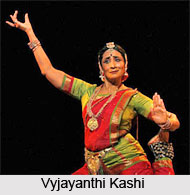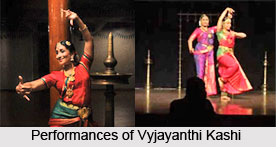 Vyjayanthi Kashi is an Indian Kuchipudi dancer popular not only among the Indian audience, but also among the overseas audience. Her style of dance is praiseworthy to the critics and she was proficient in theatre also. Vyjayanthi Kashi is a reputed Kuchipudi dancer, a celebrated performer and choreographer and artistic director of a dance school Shambhavi School of Dance, where they teach this traditional dance form Kuchipudi.
Vyjayanthi Kashi is an Indian Kuchipudi dancer popular not only among the Indian audience, but also among the overseas audience. Her style of dance is praiseworthy to the critics and she was proficient in theatre also. Vyjayanthi Kashi is a reputed Kuchipudi dancer, a celebrated performer and choreographer and artistic director of a dance school Shambhavi School of Dance, where they teach this traditional dance form Kuchipudi.
Early Life of Vyjayanthi Kashi
Vyjayanthi Kashi is a classical dance form of Andhra Pradesh. She is from the family of Dr Gubbi Veeranna who was an Indian theatre director, one of the pioneers and most prolific contributors to Kannada theatre. He established the drama company, Gubbi Veeranna Nataka Company that played a crucial role in promoting the Kannada theatre. Vyjayanthi Kashi is the daughter of the late J.M. Vishwanth and late G.V. Girijamma. Vyjayanthi Kashi started learning Bharatanatyam from Ramanna of Tumkur at the age of six. Eventually, she topped the State with a first rank and also won a golden chain. Initially she was not so interested in dance, so eventually she took theatre where she worked with T. S. Nagabharana who is an Indian film director, in the Kannada film industry.
Career of Vyjayanthi Kashi
 Vyjayanthi Kashi started dancing Kuchipudi Dance again at the age of 30. Having had her training in Bharatnatyam Dance, Kuchipudi and Temple Ritual dances from an early age under legendary dancers like Guru C R Acharya, Vedantham Prahalada Sarma, Padmashree Vedantham Satyanarayana Sharma, Bharathakala Prapoorarna, Korada Narasimha Rao. Vyjayanthi Kashi is celebrated not only for her deep and composite understanding of the art of Kuchipudi Dance, but also as an actress on television and theatre and her work as a choreographer, dance-educator and dance-therapist is inevitable.
Vyjayanthi Kashi started dancing Kuchipudi Dance again at the age of 30. Having had her training in Bharatnatyam Dance, Kuchipudi and Temple Ritual dances from an early age under legendary dancers like Guru C R Acharya, Vedantham Prahalada Sarma, Padmashree Vedantham Satyanarayana Sharma, Bharathakala Prapoorarna, Korada Narasimha Rao. Vyjayanthi Kashi is celebrated not only for her deep and composite understanding of the art of Kuchipudi Dance, but also as an actress on television and theatre and her work as a choreographer, dance-educator and dance-therapist is inevitable.
The works of Vyjayanthi Kashi has been featured in several international and national level dance and theatre festivals, including the International Kuchipudi Convention USA, Milap Fest United Kingdom, Oriental Dance Festival Germany, Festival of India in Africa, India Film Festival in Malaga, Appan Dance Festival in Korea, Olympic Festival in Italy, International Kannada Convention at Los Angeles, International Dance and Music Festival in Egypt, Malta, Tunisia, Karmiel Dance Festival in Israel and many national and international level festivals. She has given lecture-demonstration and conducted workshops in many universities in the United States, Italy, Germany, Italy, Dubai, Singapore, Malaysia, Japan, Berlin, Australia, Austria, Spain, Switzerland, and many other foreign countries.
Personal Life of Vyjayanthi Kashi
Vyjayanthi Kashi married Vijaya Kashi, who is a television and theatre artist whom she met while acting in theatre. Vyjayanthi Kashi took up a job in a bank which later she left as she fully dedicated to dance. The couple is blessed with a daughter Prateeksha Kashi, who is also a Kuchipudi dancer.



















